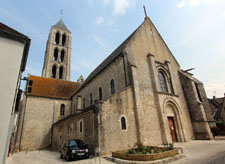Château-Landon (Seine-et-Marne, France) - Notre-Dame-de-l'Assomption
- Disclaimer
The dating found here is based on the work of John James, and is meant on this site to serve as a starting point. James' dating is derived from a system that uses his interpretation of the development of capitals over time as the basis for chronology, among other factors. His goal is to refine the dating to within years rather than decades. I have not fully embraced James' methodology, and will be developing this page from its current state to one which is admittedly more conservative. The relative expenditure values found in the Timeline are also based on James' work, and I believe these to be reasonably reliable. They are intended only to give a sense of the amount of work involved in each decade.
I have added the idea of the "project" as a way of separating work in buildings. In my mind, a "project" is a discrete section of work in a building that resulted from the one-time acquisition of funding. "Projects" are generally separated by at least a decade where no work was being done. It is my view that it would have been unwise to start a "project" that could not be finished and protected from the elements, and as such a "project" usually involved a wing or multiple wings of a building, from floor to roof. Rural churches, which could only secure small amounts of funding at irregular intervals, often were the result of many small projects, while the great churches, which benefitted from relatively consistent funding, may have involved only a few large projects.
I have added the idea of the "project" as a way of separating work in buildings. In my mind, a "project" is a discrete section of work in a building that resulted from the one-time acquisition of funding. "Projects" are generally separated by at least a decade where no work was being done. It is my view that it would have been unwise to start a "project" that could not be finished and protected from the elements, and as such a "project" usually involved a wing or multiple wings of a building, from floor to roof. Rural churches, which could only secure small amounts of funding at irregular intervals, often were the result of many small projects, while the great churches, which benefitted from relatively consistent funding, may have involved only a few large projects.
- Timeline with Relative Expenditure (if available, in building units)
 |
 |
 |
 |
- Project A - Earlier - Phase 1 -
North nave aisle wall with herringbone coursing, date uncertain
- Project B - 1070s - Phase 2 - west (a)
West wall as a 2-storey ashlar panel with sidewalls in rubble; it may have been connected to the side walls;
- Project B - 1070s - Phase 3 - west (c)
Upper part of west wall with window
- Project C - 1120s - Phase 4 - choir (b)
Lower choir walls with the same little figures at the bases; the stub for north nave, and on south a shaft; the base of this shaft turns to the west as if for a wall but does not align with the remains of the south wall that is displayed in the clerestory; the tops of the splays into the north aisle are decorated with little figures; the choir sills and south transept entry portal with their capitals that were by one of the crews that later worked on the clerestory capitals.
- Project C - 1120s - Phase 5 - apse (aw)
Apse window capitals and arches; they are in a different manner to those in the vaulting capitals and are 5 courses lower.
- Project C - 1120s - Phase 6 - choir (c)
- Project C - 1120s - Phase 7 - choir (v)
Choir ribs and arches, some with triple rolls and some with flat sections; the varied profiles suggest a number of campaigns.
- Project C - 1130s - Phase 8 - nave (a)
Nave aisle arches; north nave arcade added between choir and west wall, with timber roof; the order of the stonework against the base projecting from the crossing pier suggests the arches to the west were after; yet the quality of the stonework and the quarry suggest a less sophisticated period, in which case the stub would have been inserted under the older arches.
- Project C - 1130s - Phase 9 - nave (c)
Courses of the north nave clerestory windows are tied into the soffits over the western arch; presume it had been the same in south as there are vestiges of the same windows over the inserted 15th century arches; these continue into the transepts.
- Project D - 1190s - Phase 10 - tower I, II, III
Three stories of the tower
- Project E - Later - Phase 11 -
Rebuilt south nave aisle, demolished arcade and most of the walls while leaving the upper courses and the roof in place.
